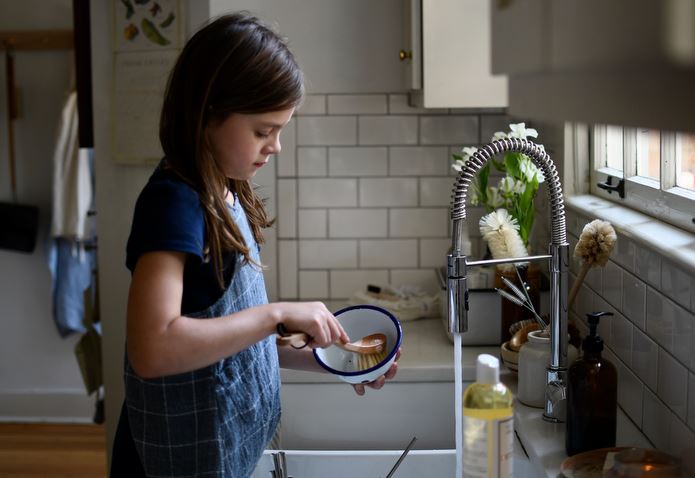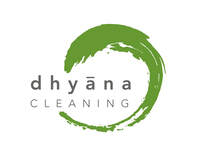As awareness of the impact of chemical cleaners on personal and environmental health grows, more people are turning to the benefits of green cleaning products and services to help them with their cleaning needs and goals.
When Katie Shulist, founder and CEO of Dhyana Cleaning, Toronto’s premier provider of green cleaning services was asked to weigh in on what green cleaning is, here’s what she said:
“Green cleaning isn’t just cleaning for appearance. It’s cleaning for health, so the outcome is different.”
While of course green cleaning takes appearance into consideration, it’s a holistic process that also considers human, animal and environmental health. For Katie, green cleaning principles inform “the products that we use, the processes that we follow and the tools as well.”
Kicking VOCs Out and Inviting Cleaning for Health In
The products Dhyana Cleaning uses are those that have low or no VOCs (volatile organic compounds) which are, says Katie, “damaging to the planet and to people’s health. They not only damage the environment—they can damage the air in our homes.”
VOCs have been linked to cancers, birth defects, hormone disruptions, and neurological disorders (Bably & Arif, 2019, McDonald et al 2018)). Katie says the use of harsh chemicals goes against green cleaning principles which are “to remove germs and bacteria to create a space that’s healthy so that you can thrive.”
From Thriving to Dhyana Cleaning’s Mindful Cleaning Movement
It’s that thriving element that has really driven Katie to become one of Toronto’s foremost providers of eco-friendly, green cleaning services. She is passionate about what it means to truly thrive, and how she can help her clients and her employees develop opportunities for personal growth. Enter Dhyana Cleaning’s Mindful Cleaning Movement.
After reading a book on Buddhism back in 2005, Katie remembers thinking that she was learning to apply the same kinds of teachings she was reading about in her daily work as a cleaner.
“It opened up a world of non-judgement for me because I saw our universal, shared humanity. Going into other people’s private spaces, you see their struggles. You see their wins and their losses.”
Noticing all of this gave Katie the opportunity to relate to her clients and their cleaning goals on a deeper level. Reflecting on those early days she says, “I think that shared humanity is the first lesson cleaners learn.”
Katie’s expertise in green cleaning led her to seek out a path that most resembled how she felt about the cleaning process itself. Mindful cleaning is “a way to get in touch with how you’re feeling in the present moment,” she says, and it offers “a practice to build present moment awareness. Once you become aware of what is coming up inside, you can choose to put those thoughts aside, in service for the person you are serving, as well as for yourself. It’s a practice in humility.”
Ultimately, mindful cleaning is “a practice to build loving kindness for yourself and also to build that for the people you’re cleaning for.”
And if all that weren’t enough, Katie Shulist’s Mindful Cleaning Movement is one that offers “a practice to become more self-aware, which is so important for well-being.”
Research into the positive effects of mindfulness meditation are numerous, and studies show benefits such as decreasing anxiety, improving emotional regulation, improving attention regulation, and positive change on perspective of the self (Holzel, et al 2011, Hulsheger et al 2013, Davis & Hayes, 2011).
Revealing the Beauty of a Space to Reveal the Beauty Within
Katie was inspired to create a way for people to learn about these principles, whether they practiced mindfulness or not. She developed #revealbeauty to help her employees, clients, and those using the green cleaning resources on her website as a way to begin to develop the self-awareness that mindful cleaning can offer.
Katie’s #revealbeauty reflects her philosophy that through mindful cleaning, as you “reveal the beauty in your space, you become more spacious in yourself, thereby revealing the beauty within.”
Katie’s vision includes all people who are engaging in the cleaning process, whether they are a professional, like her employees, or someone cleaning their own space.
In fact, gaining such expansive personal growth opportunities from her own commitment to mindful cleaning and revealing beauty was what motivated Katie to expand her company. Dhyana Cleaning also invests in their employees by offering them learning and development opportunities and supporting them to develop the unique strengths within themselves.
Katie is committed to providing green cleaning services and helping others learn to clean mindfully as an opportunity to develop self-growth and awareness. She’s also aware of the powerful mental-health benefits of a clean and organized space where “not only germs and bacteria are being removed, but by organizing, the visual aspect of order helps to lower stress.”
Katie’s experiences and understandings of how a clean, organized space can lower stress echo recent scientific studies that saw a direct correlation between higher reported stress levels and clutter (Arnold et al, 2012, Roster et al, 2016).
“It was from that awareness and that practice that I thought ‘this is what I want to teach other people. This is what I want other cleaners to experience.’”
Mindful (Green) Cleaning to Transition from Work Mode to Home Mode
While mindful cleaning can benefit everyone, it can be particularly helpful when transitioning from work mode to home mode. This is especially true when so many people are missing the physical division of these spaces.
There’s no longer that separation between work and home, Katie says, and a 20-minute round of mindful cleaning at the beginning and end of the workday can help. This provides a way for those working from home to check in with themselves, slow down, and be more completely present when it’s time to shut the computer off.
Given the complexities of our current times, a practice that can help deepen self- awareness, lower stress and anxiety, and help get the house in order sounds like just the thing. Katie’s Clear Mind program is one that offers immersive training in how to begin and then continue a practice of mindful cleaning. In the meantime, Katie says anyone can become more mindful when cleaning with her 5 easy tips.
Katie’s 5 Easy Tips to Practice Mindful Cleaning
- Set your intention (for example, do you want to increase your energy or learn to become more patient?)
- Make it easy to get started by committing to a small task for 1-5 minutes. Starting is the most challenging part!
- Make a plan. This creates an efficiency-mindset while conserving energy and making the best use of your time. (Stay tuned for the next post that covers this tip in more detail!).
- Focus on your environment. Appreciate what you have and what you are cleaning. Are the items in your space gifts from a loved one? What about the care that was taken by all of the people who made the products in your home? This teaches us about our interconnectedness.
- Set a timer and get as much done as possible within the time frame and without judgement. This helps you to drop into focus – focus on the next immediate step – not too far into the future, just moment to moment awareness of revealing the beauty of your space and within.
Adrienne Kitchin is a freelance health and education writer as well as a Liberal Studies and Anthropology Professor at Humber College in Toronto, Canada. She can be found on LinkedIn .
Join our Mindful Cleaning Movement! Click here for Emails that #RevealBeauty
Looking for a professional green cleaning service in Toronto? Contact our team for a free estimate.
Arnold, J.E., Graesch, A.P., Ragazzini, E., & Ochs. E. (2012). Life at Home in the 21st Century. The Cotsen Institute of Archaeology Press.
Davis, D. M., & Hayes, J. A. (2011). What are the benefits of mindfulness? A practice review of psychotherapy-related research. Psychotherapy, 48(2), 198-208. doi:10.1037/a0022062
Hölzel, B.K., Lazar S.W., Gard, T., Schuman-Olivier, Z., Vago, D.R., & Ott, U. (2011, November). How Does Mindfulness Meditation Work? Proposing Mechanisms of Action from a Conceptual and Neural Perspective. Perspectives on Psychological Science, (6)6, 537-559.
Hülsheger, U. R., Alberts, H. J. E. M., Feinholdt, A., & Lang, J. W. B. (2013). Benefits of mindfulness at work: The role of mindfulness in emotion regulation, emotional exhaustion, and job satisfaction. Journal of Applied Psychology, 98(2), 310-325. http://dx.doi.org.proxy.library.brocku.ca/10.1037/a0031313
McDonald, B.C., DeGouw J.A., Gilman J.B., Jathar, S.H., Akherati, A., Cappa, C.D., Jimenez, J.L., Lee-Taylor, J., Hayes. P.L., McKeen, S.A., Cui, Y.Y., Kim, S-W., Gentner, D.R., Isaacman-Vanwertz, G., Goldstein, A.H., Harley R.A., Frost, G.J., Roberts, J.M., Ryerson, T.B., Trainer, M. (2018, February). Volatile chemical products emerging as largest petrochemical source of urban organic emissions. Science, 760-764.
Roster, C.A., Ferrari, J.R., & Jurkat, M.P. (2016). The Dark Side of Home: Assessing Possession ‘clutter’ on Subjective Well-Being. Journal of environmental psychology 46, 32–41.


 RSS Feed
RSS Feed
